IT273 - Module 4: Configuring WAN and Wireless Networks
VerifiedAdded on 2023/06/03
|9
|997
|50
Practical Assignment
AI Summary
This assignment solution details the configuration of Wide Area Networks (WANs) and wireless technologies, focusing on the setup of serial links, Point-to-Point Protocol (PPP) encapsulation, and Challenge Handshake Authentication Protocol (CHAP). The solution outlines the configuration steps for three labs: Lab 11.2.4, which involves setting up serial links between routers with PPP encapsulation and CHAP authentication; Lab 10.3.4, which focuses on establishing a wireless connection; and Lab 10.5.4, which covers configuring initial wireless network settings. The solution provides the necessary commands and configurations for each lab, including IP address assignments, encapsulation settings, CHAP authentication configurations, and wireless network parameters. The assignment demonstrates how to configure routers and wireless devices to establish secure and functional WAN and wireless networks, including the use of authentication protocols.
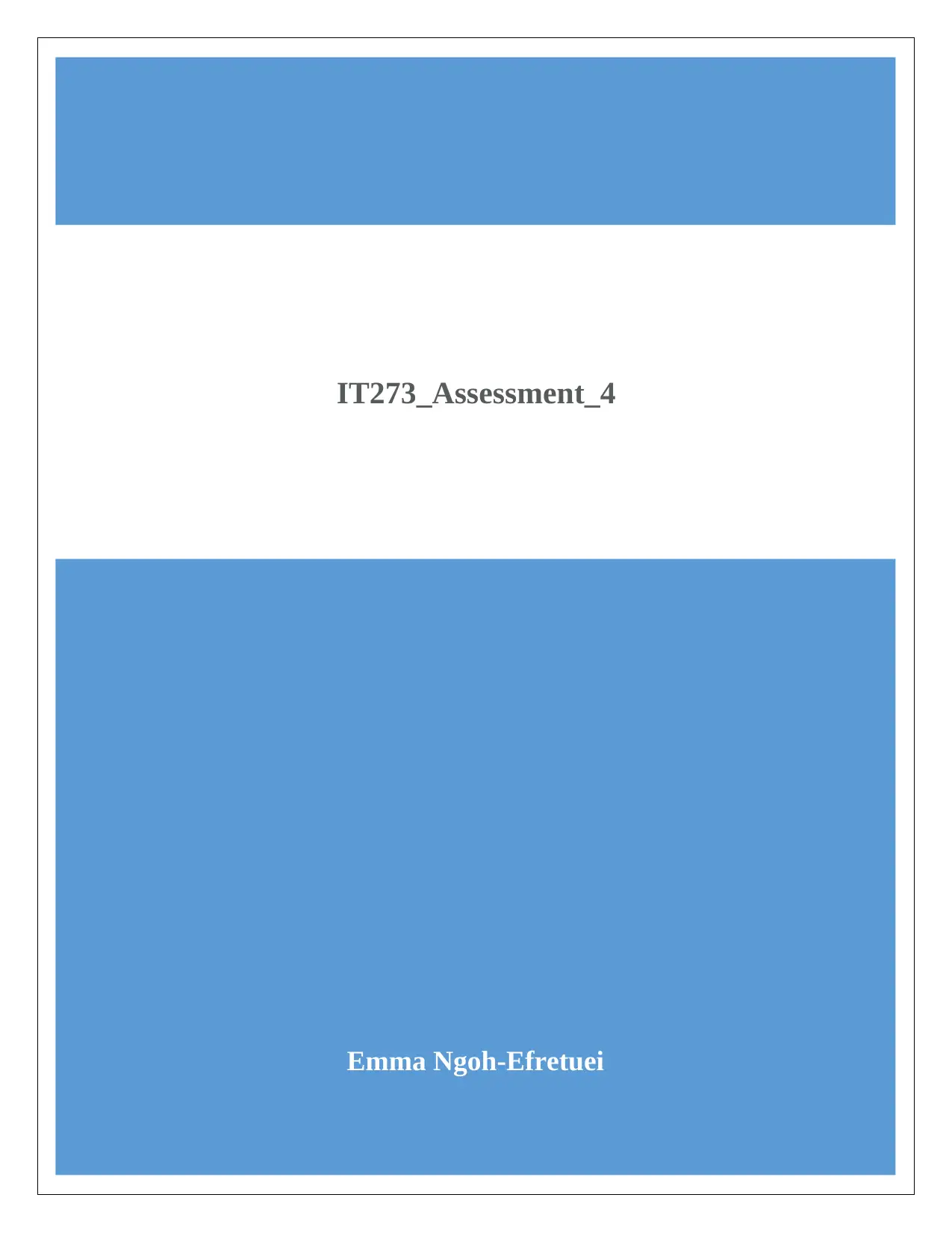
Emma Ngoh-Efretuei
IT273_Assessment_4
IT273_Assessment_4
Paraphrase This Document
Need a fresh take? Get an instant paraphrase of this document with our AI Paraphraser
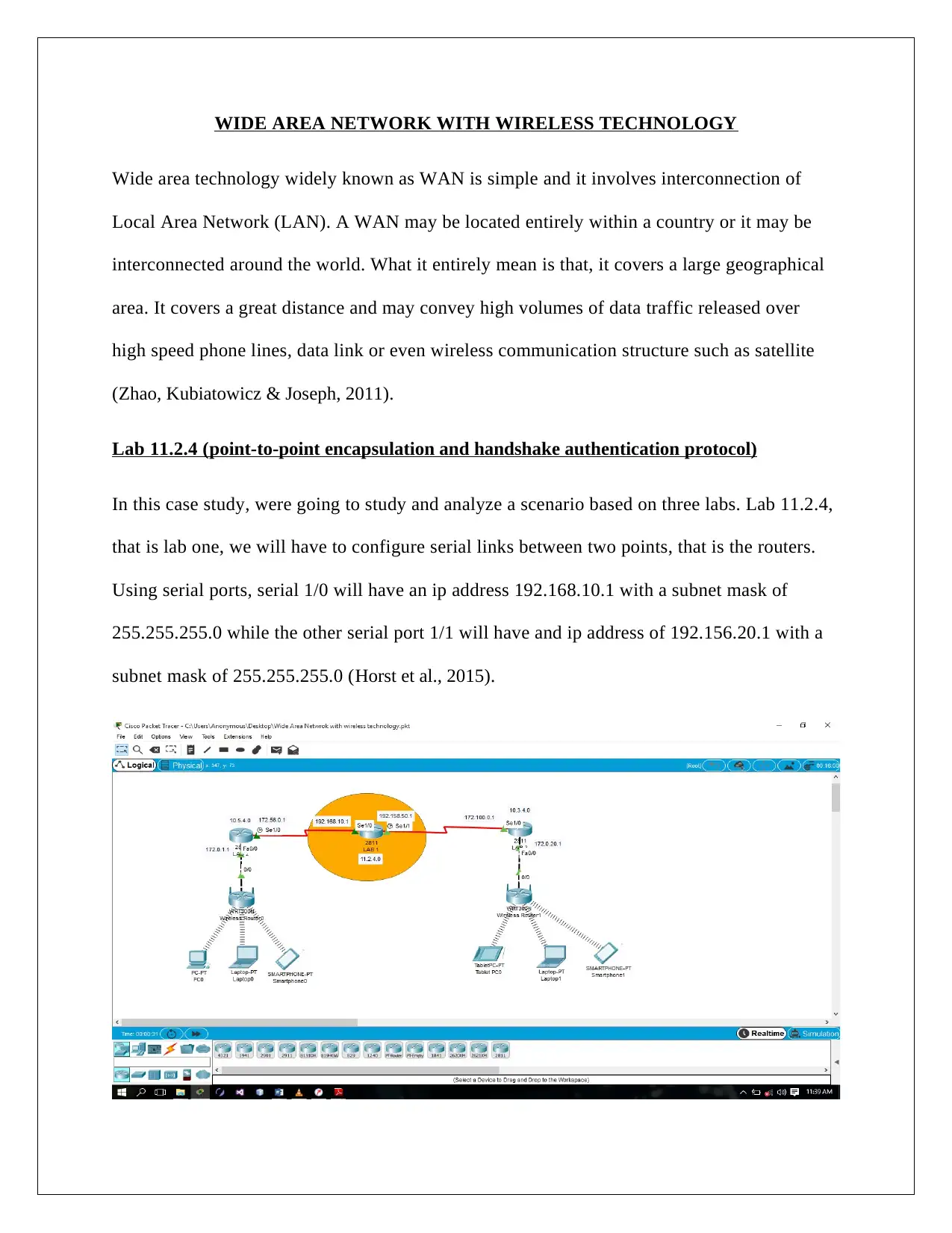
WIDE AREA NETWORK WITH WIRELESS TECHNOLOGY
Wide area technology widely known as WAN is simple and it involves interconnection of
Local Area Network (LAN). A WAN may be located entirely within a country or it may be
interconnected around the world. What it entirely mean is that, it covers a large geographical
area. It covers a great distance and may convey high volumes of data traffic released over
high speed phone lines, data link or even wireless communication structure such as satellite
(Zhao, Kubiatowicz & Joseph, 2011).
Lab 11.2.4 (point-to-point encapsulation and handshake authentication protocol)
In this case study, were going to study and analyze a scenario based on three labs. Lab 11.2.4,
that is lab one, we will have to configure serial links between two points, that is the routers.
Using serial ports, serial 1/0 will have an ip address 192.168.10.1 with a subnet mask of
255.255.255.0 while the other serial port 1/1 will have and ip address of 192.156.20.1 with a
subnet mask of 255.255.255.0 (Horst et al., 2015).
Wide area technology widely known as WAN is simple and it involves interconnection of
Local Area Network (LAN). A WAN may be located entirely within a country or it may be
interconnected around the world. What it entirely mean is that, it covers a large geographical
area. It covers a great distance and may convey high volumes of data traffic released over
high speed phone lines, data link or even wireless communication structure such as satellite
(Zhao, Kubiatowicz & Joseph, 2011).
Lab 11.2.4 (point-to-point encapsulation and handshake authentication protocol)
In this case study, were going to study and analyze a scenario based on three labs. Lab 11.2.4,
that is lab one, we will have to configure serial links between two points, that is the routers.
Using serial ports, serial 1/0 will have an ip address 192.168.10.1 with a subnet mask of
255.255.255.0 while the other serial port 1/1 will have and ip address of 192.156.20.1 with a
subnet mask of 255.255.255.0 (Horst et al., 2015).
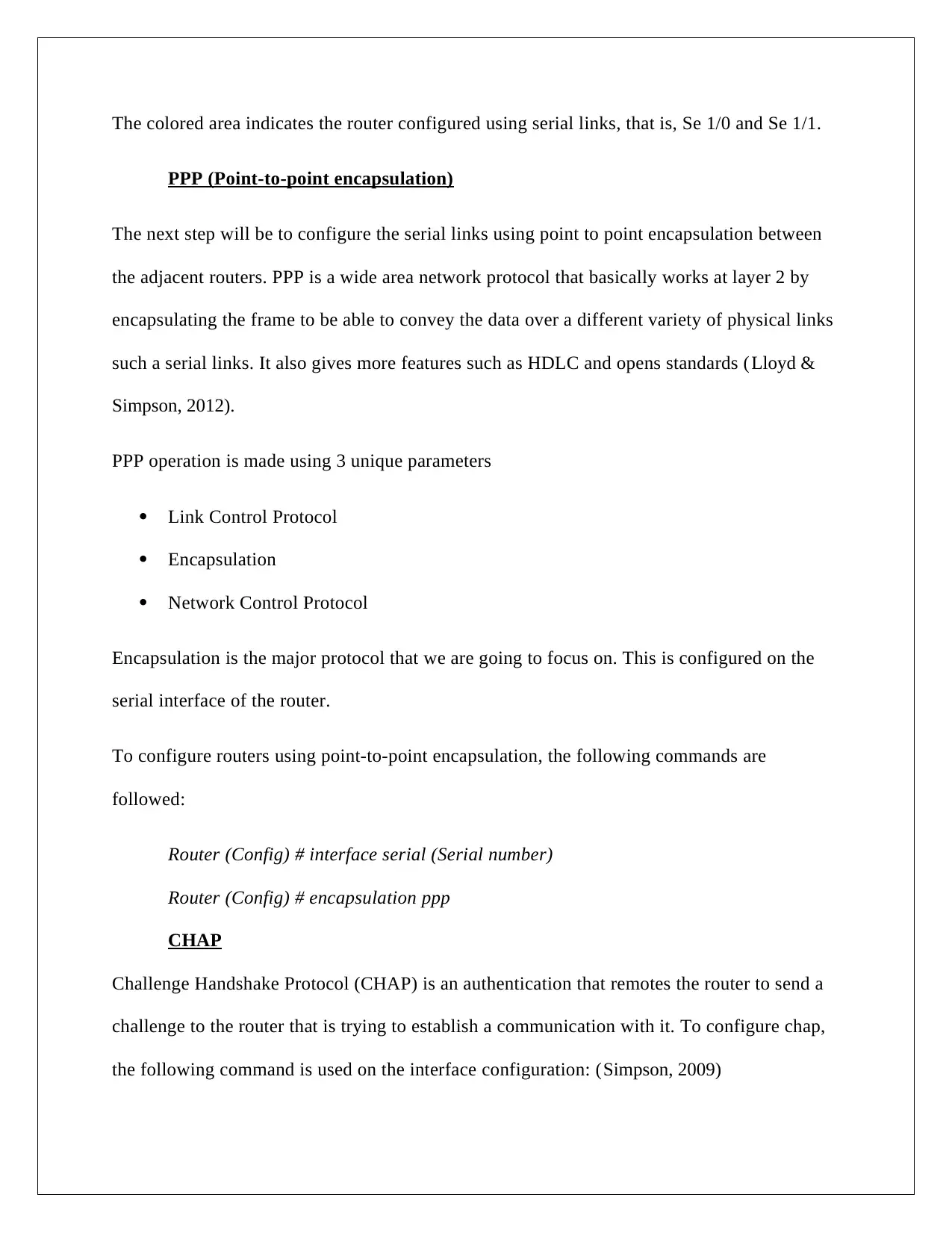
The colored area indicates the router configured using serial links, that is, Se 1/0 and Se 1/1.
PPP (Point-to-point encapsulation)
The next step will be to configure the serial links using point to point encapsulation between
the adjacent routers. PPP is a wide area network protocol that basically works at layer 2 by
encapsulating the frame to be able to convey the data over a different variety of physical links
such a serial links. It also gives more features such as HDLC and opens standards (Lloyd &
Simpson, 2012).
PPP operation is made using 3 unique parameters
Link Control Protocol
Encapsulation
Network Control Protocol
Encapsulation is the major protocol that we are going to focus on. This is configured on the
serial interface of the router.
To configure routers using point-to-point encapsulation, the following commands are
followed:
Router (Config) # interface serial (Serial number)
Router (Config) # encapsulation ppp
CHAP
Challenge Handshake Protocol (CHAP) is an authentication that remotes the router to send a
challenge to the router that is trying to establish a communication with it. To configure chap,
the following command is used on the interface configuration: (Simpson, 2009)
PPP (Point-to-point encapsulation)
The next step will be to configure the serial links using point to point encapsulation between
the adjacent routers. PPP is a wide area network protocol that basically works at layer 2 by
encapsulating the frame to be able to convey the data over a different variety of physical links
such a serial links. It also gives more features such as HDLC and opens standards (Lloyd &
Simpson, 2012).
PPP operation is made using 3 unique parameters
Link Control Protocol
Encapsulation
Network Control Protocol
Encapsulation is the major protocol that we are going to focus on. This is configured on the
serial interface of the router.
To configure routers using point-to-point encapsulation, the following commands are
followed:
Router (Config) # interface serial (Serial number)
Router (Config) # encapsulation ppp
CHAP
Challenge Handshake Protocol (CHAP) is an authentication that remotes the router to send a
challenge to the router that is trying to establish a communication with it. To configure chap,
the following command is used on the interface configuration: (Simpson, 2009)
⊘ This is a preview!⊘
Do you want full access?
Subscribe today to unlock all pages.

Trusted by 1+ million students worldwide
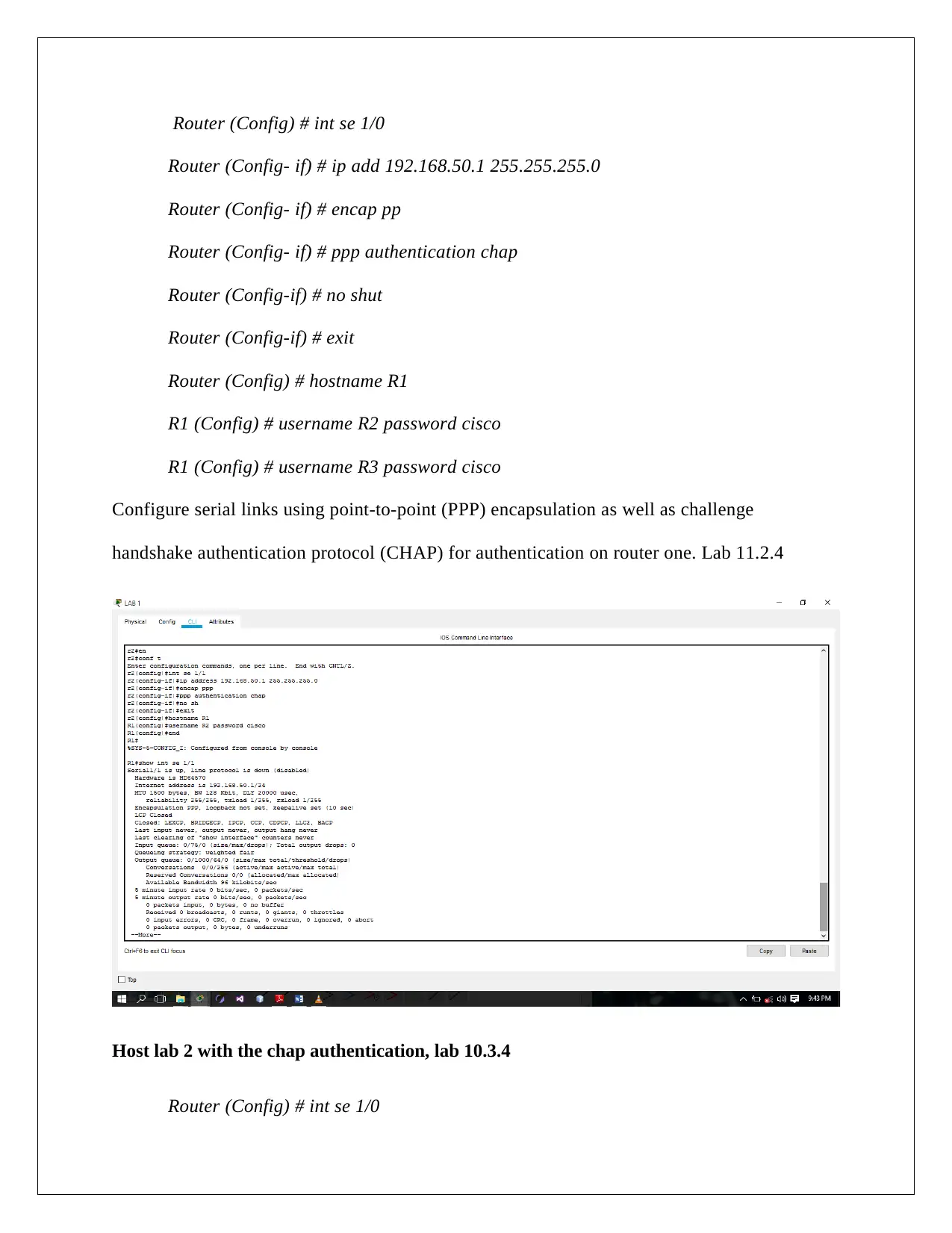
Router (Config) # int se 1/0
Router (Config- if) # ip add 192.168.50.1 255.255.255.0
Router (Config- if) # encap pp
Router (Config- if) # ppp authentication chap
Router (Config-if) # no shut
Router (Config-if) # exit
Router (Config) # hostname R1
R1 (Config) # username R2 password cisco
R1 (Config) # username R3 password cisco
Configure serial links using point-to-point (PPP) encapsulation as well as challenge
handshake authentication protocol (CHAP) for authentication on router one. Lab 11.2.4
Host lab 2 with the chap authentication, lab 10.3.4
Router (Config) # int se 1/0
Router (Config- if) # ip add 192.168.50.1 255.255.255.0
Router (Config- if) # encap pp
Router (Config- if) # ppp authentication chap
Router (Config-if) # no shut
Router (Config-if) # exit
Router (Config) # hostname R1
R1 (Config) # username R2 password cisco
R1 (Config) # username R3 password cisco
Configure serial links using point-to-point (PPP) encapsulation as well as challenge
handshake authentication protocol (CHAP) for authentication on router one. Lab 11.2.4
Host lab 2 with the chap authentication, lab 10.3.4
Router (Config) # int se 1/0
Paraphrase This Document
Need a fresh take? Get an instant paraphrase of this document with our AI Paraphraser
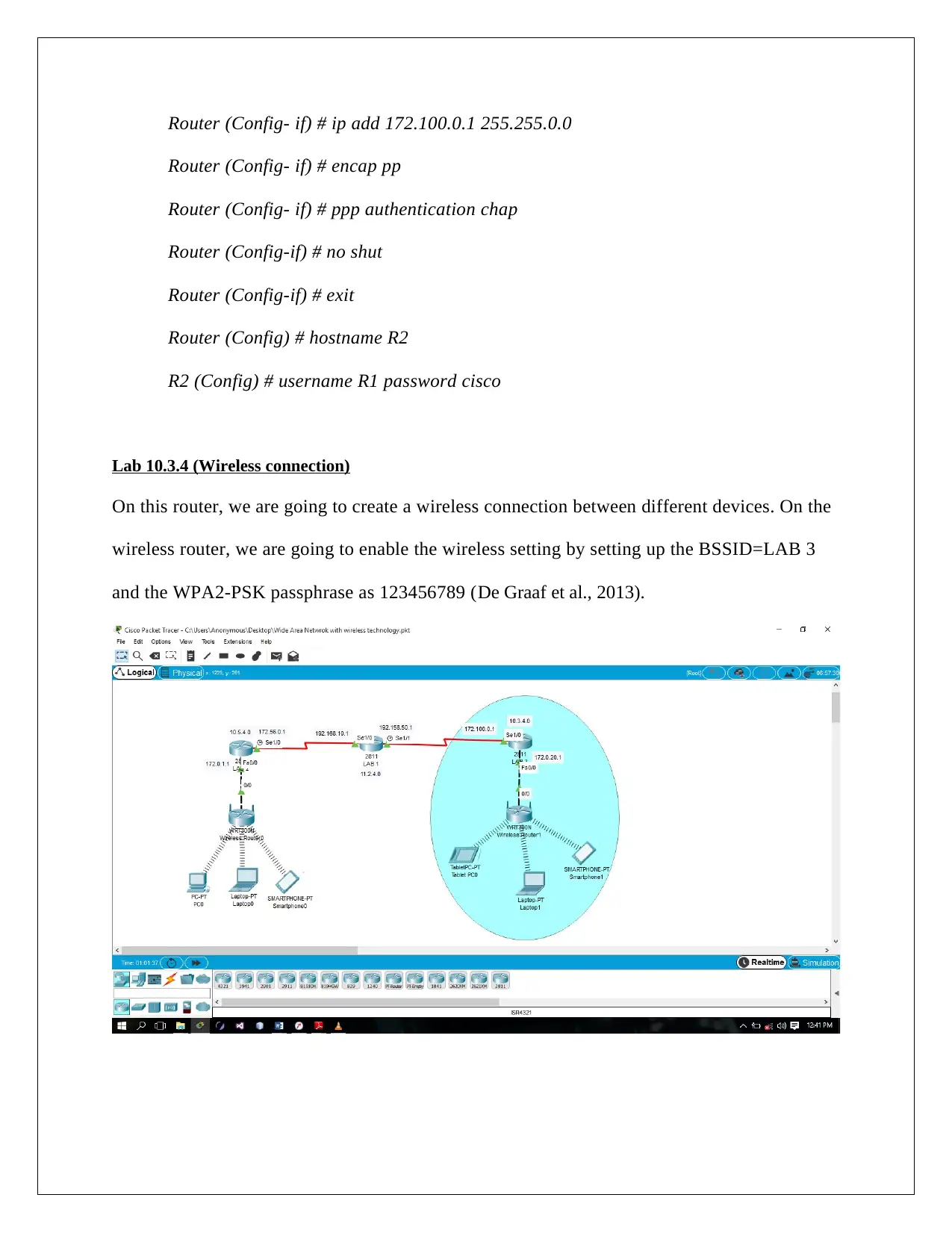
Router (Config- if) # ip add 172.100.0.1 255.255.0.0
Router (Config- if) # encap pp
Router (Config- if) # ppp authentication chap
Router (Config-if) # no shut
Router (Config-if) # exit
Router (Config) # hostname R2
R2 (Config) # username R1 password cisco
Lab 10.3.4 (Wireless connection)
On this router, we are going to create a wireless connection between different devices. On the
wireless router, we are going to enable the wireless setting by setting up the BSSID=LAB 3
and the WPA2-PSK passphrase as 123456789 (De Graaf et al., 2013).
Router (Config- if) # encap pp
Router (Config- if) # ppp authentication chap
Router (Config-if) # no shut
Router (Config-if) # exit
Router (Config) # hostname R2
R2 (Config) # username R1 password cisco
Lab 10.3.4 (Wireless connection)
On this router, we are going to create a wireless connection between different devices. On the
wireless router, we are going to enable the wireless setting by setting up the BSSID=LAB 3
and the WPA2-PSK passphrase as 123456789 (De Graaf et al., 2013).
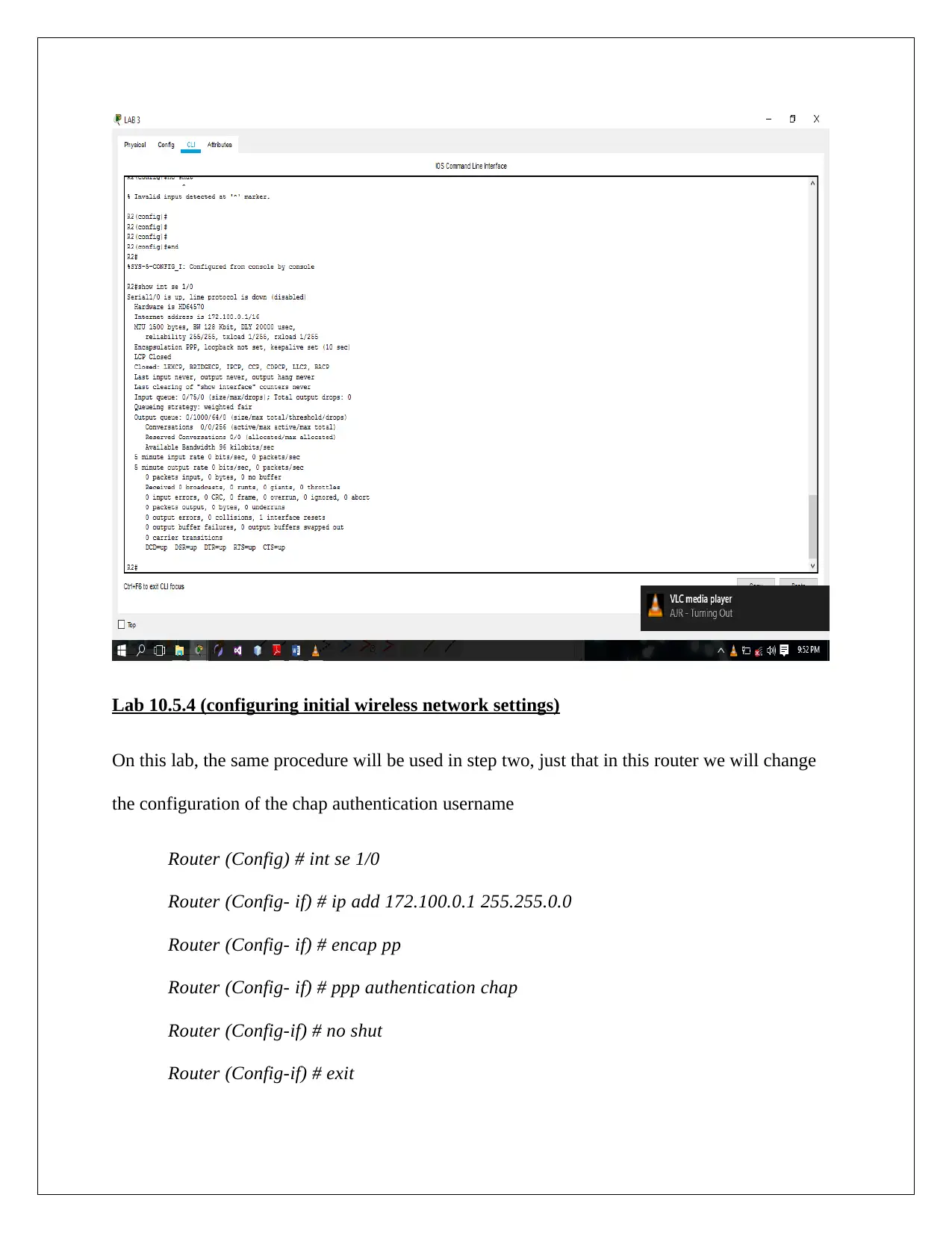
Lab 10.5.4 (configuring initial wireless network settings)
On this lab, the same procedure will be used in step two, just that in this router we will change
the configuration of the chap authentication username
Router (Config) # int se 1/0
Router (Config- if) # ip add 172.100.0.1 255.255.0.0
Router (Config- if) # encap pp
Router (Config- if) # ppp authentication chap
Router (Config-if) # no shut
Router (Config-if) # exit
On this lab, the same procedure will be used in step two, just that in this router we will change
the configuration of the chap authentication username
Router (Config) # int se 1/0
Router (Config- if) # ip add 172.100.0.1 255.255.0.0
Router (Config- if) # encap pp
Router (Config- if) # ppp authentication chap
Router (Config-if) # no shut
Router (Config-if) # exit
⊘ This is a preview!⊘
Do you want full access?
Subscribe today to unlock all pages.

Trusted by 1+ million students worldwide
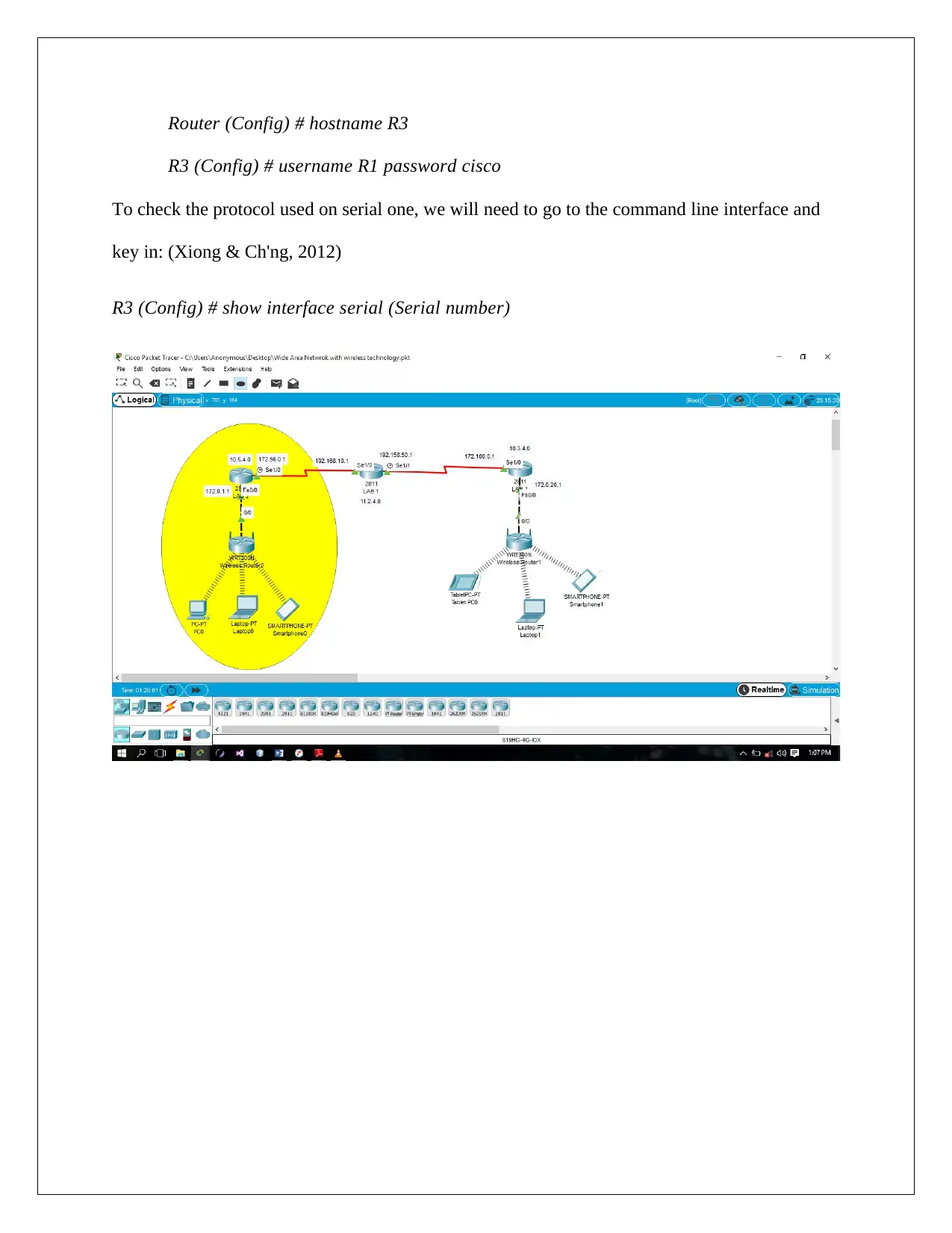
Router (Config) # hostname R3
R3 (Config) # username R1 password cisco
To check the protocol used on serial one, we will need to go to the command line interface and
key in: (Xiong & Ch'ng, 2012)
R3 (Config) # show interface serial (Serial number)
R3 (Config) # username R1 password cisco
To check the protocol used on serial one, we will need to go to the command line interface and
key in: (Xiong & Ch'ng, 2012)
R3 (Config) # show interface serial (Serial number)
Paraphrase This Document
Need a fresh take? Get an instant paraphrase of this document with our AI Paraphraser
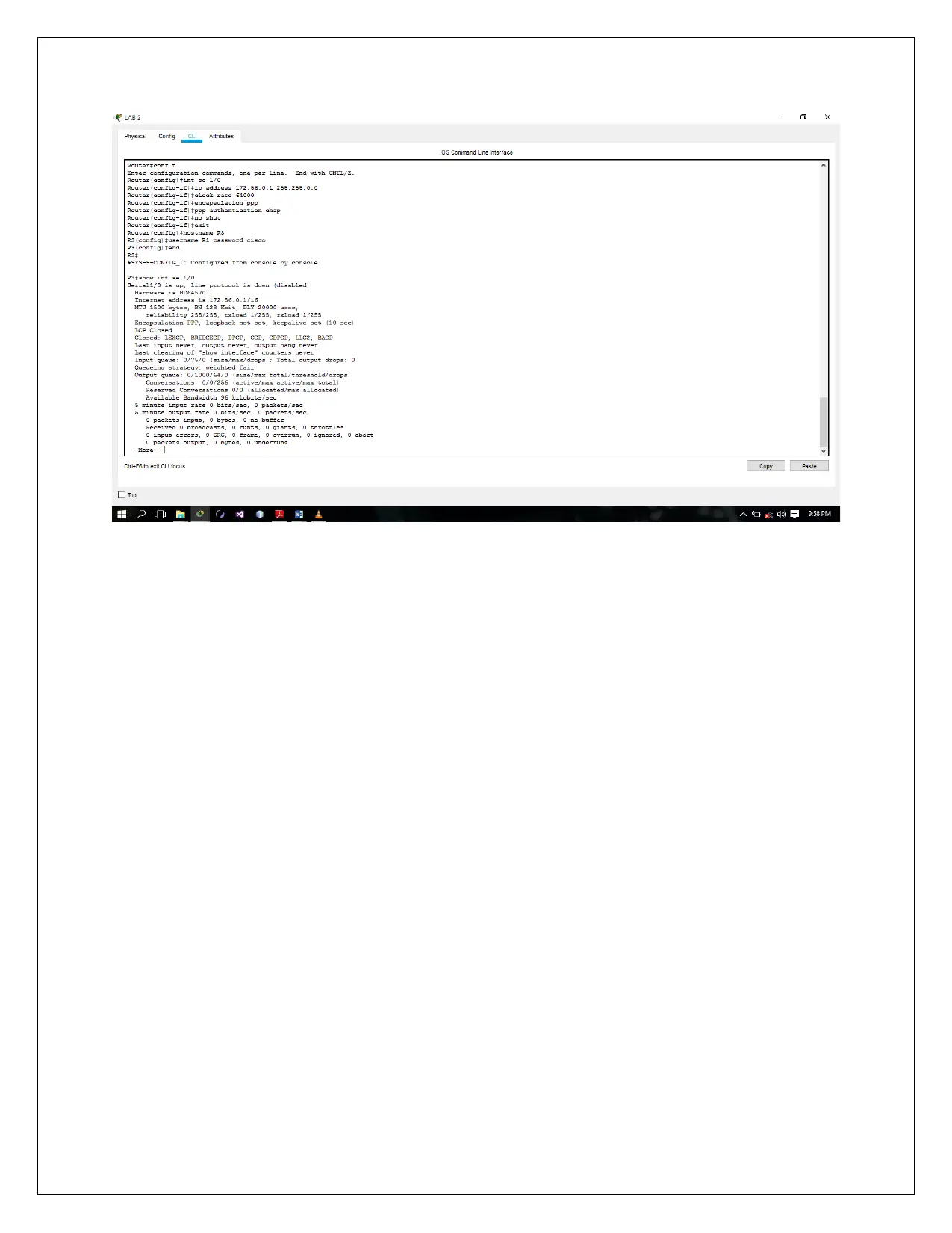
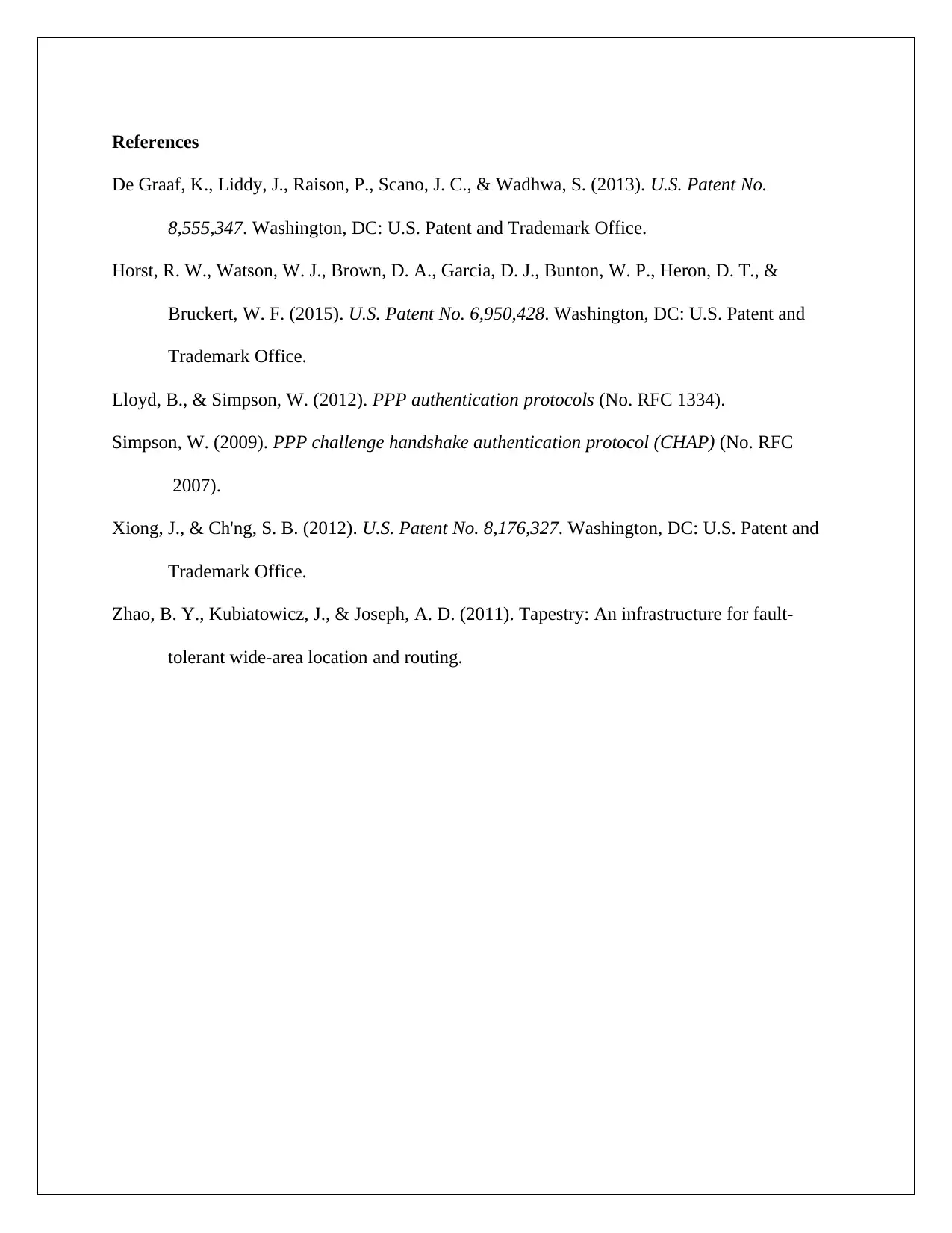
References
De Graaf, K., Liddy, J., Raison, P., Scano, J. C., & Wadhwa, S. (2013). U.S. Patent No.
8,555,347. Washington, DC: U.S. Patent and Trademark Office.
Horst, R. W., Watson, W. J., Brown, D. A., Garcia, D. J., Bunton, W. P., Heron, D. T., &
Bruckert, W. F. (2015). U.S. Patent No. 6,950,428. Washington, DC: U.S. Patent and
Trademark Office.
Lloyd, B., & Simpson, W. (2012). PPP authentication protocols (No. RFC 1334).
Simpson, W. (2009). PPP challenge handshake authentication protocol (CHAP) (No. RFC
2007).
Xiong, J., & Ch'ng, S. B. (2012). U.S. Patent No. 8,176,327. Washington, DC: U.S. Patent and
Trademark Office.
Zhao, B. Y., Kubiatowicz, J., & Joseph, A. D. (2011). Tapestry: An infrastructure for fault-
tolerant wide-area location and routing.
De Graaf, K., Liddy, J., Raison, P., Scano, J. C., & Wadhwa, S. (2013). U.S. Patent No.
8,555,347. Washington, DC: U.S. Patent and Trademark Office.
Horst, R. W., Watson, W. J., Brown, D. A., Garcia, D. J., Bunton, W. P., Heron, D. T., &
Bruckert, W. F. (2015). U.S. Patent No. 6,950,428. Washington, DC: U.S. Patent and
Trademark Office.
Lloyd, B., & Simpson, W. (2012). PPP authentication protocols (No. RFC 1334).
Simpson, W. (2009). PPP challenge handshake authentication protocol (CHAP) (No. RFC
2007).
Xiong, J., & Ch'ng, S. B. (2012). U.S. Patent No. 8,176,327. Washington, DC: U.S. Patent and
Trademark Office.
Zhao, B. Y., Kubiatowicz, J., & Joseph, A. D. (2011). Tapestry: An infrastructure for fault-
tolerant wide-area location and routing.
⊘ This is a preview!⊘
Do you want full access?
Subscribe today to unlock all pages.

Trusted by 1+ million students worldwide
1 out of 9
Related Documents
Your All-in-One AI-Powered Toolkit for Academic Success.
+13062052269
info@desklib.com
Available 24*7 on WhatsApp / Email
![[object Object]](/_next/static/media/star-bottom.7253800d.svg)
Unlock your academic potential
Copyright © 2020–2025 A2Z Services. All Rights Reserved. Developed and managed by ZUCOL.




